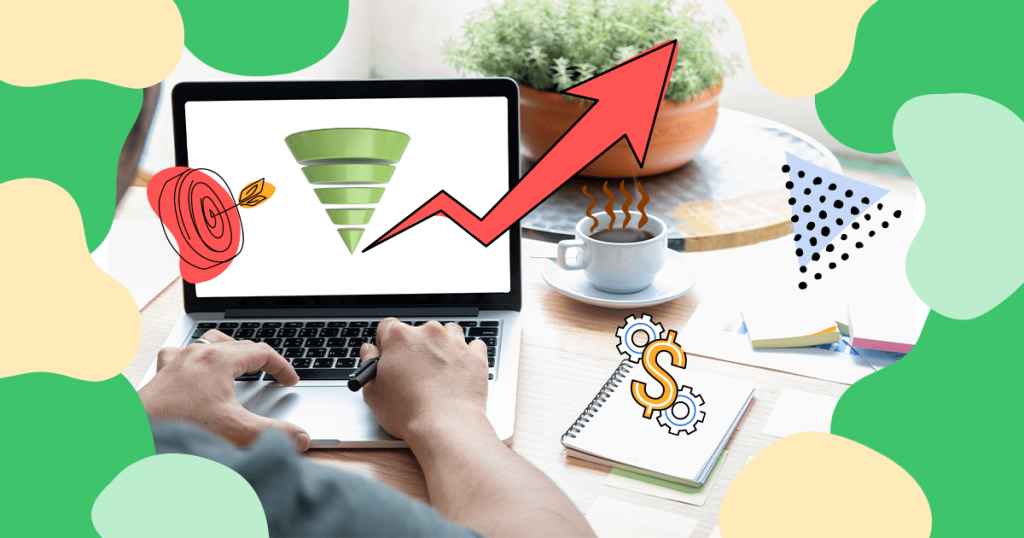A person’s journey from interested consumer to paying customer is rarely as simple as seeing a particular advertisement and deciding to make a purchase.
Most people go through an entire process that includes multiple stages, each with its own unique concerns and considerations.
This process is known as a sales funnel.
How well your sales funnel leads the people at the top all the way through each stage to the bottom can make or break your digital marketing campaign, so knowing how to optimize it is critical.
Here’s a closer look at what you need to know to not only fully understand how sales funnels work but to build one that yields the results you’re after.
What Stages Make Up a Standard Sales Funnel?
No two sales funnels are exactly alike, so the precise number of stages customers will encounter along the way can vary.
However, most modern funnels have four key stages in common:
Awareness
This is the earliest stage of a typical sales funnel — the stage where consumers have pain points that your product or service may rectify.
They are not yet aware of you or what your company brings to the table. This is the stage where they become aware via engaging, high-quality content that addresses their needs.
Evaluation
This is the stage where your prospective customer begins to consider a product, service, or brand that’s successfully captured their attention.
They’re weighing whether or not you can truly solve their problem. But they’re likely considering your competition, as well, so continuing to engage in the right way is vital at this stage.
Comparison
During this phase, your sales prospect has likely decided to buy your product or something similar but is wondering which of their options is best.
They’re comparing prices and figuring out which choice makes the most sense given their budget, needs, and desires.
Conversion
At this point, your prospective customer has successfully progressed through all the previous stages and reached the bottom of your funnel.
By now, they should know everything they need to know about you and your products to finalize a purchase.
It’s up to the marketer to make saying yes to that purchase as easy as possible.
What is Sales Funnel Optimization?
Even the best sales funnels will lose a few people at each step along the way.
However, comprehensive optimization can keep those losses as low and inconsequential as possible. Sales funnel optimization is one approach to making sure that happens.
It also involves adopting a narrower approach to converting a lead into a paying customer, focusing solely on the end stage of the process — the stage where the person definitively decides whether or not to pull the trigger on a purchase.
In general, sales funnel optimization campaigns focus on:
- One conversion path, a single potential transaction, or both.
- Convincing a single person to complete the desired action.
- Converting prospects via a single landing page or purchase interface.
A marketer working on an approach to sales funnel optimization will look at how well a specific ad campaign is driving sales for a particular product or service.
The total return on investment (ROI) is determined fairly simply — by assessing the cost of the advertising campaign versus the dollar amount generated in sales.
What is Full Funnel Optimization?
Full funnel optimization is similar to sales funnel optimization in basic execution, but it’s significantly more expansive.
Instead of hyper-focusing on only the steps concerned with pushing sales, a full-funnel approach considers the entire journey a consumer takes from the time they learn about a product to the day they purchase it and beyond.
Optimizing with your entire sales funnel in mind acknowledges how complex a purchasing decision may actually be.
It considers the importance modern consumers place on building a long-term, personal relationship with the companies they buy from.
It leverages the potential impact factors like social media presence and content development can have on a customer’s potential to make additional purchases in the future, as well.
In addition, full funnel optimization:
- Doesn’t treat the consumer buying process like a single path the person will take once. Instead, it approaches it the way you would a loop with lots of potential contact points between customers and the brands they buy from.
- Considers that there might be more than one decision-maker involved in a purchase decision, as with B2B transactions.
- Addresses the strong possibility that sales prospects will interact with a brand across multiple websites and via many different types of devices.
Marketers who take a full funnel approach to the optimization process are still concerned with closing sales, building contact lists, and so forth.
However, they also realize how crucial ongoing relationships are for brand growth, and they consider that when putting together their campaigns.
What are the Best Ways to Optimize a Marketing Funnel?
Although there’s no such thing as a perfect marketing funnel, there’s quite a lot you can do to increase the chances of succeeding with yours.
It’s all about convincing your prospects that you indeed have the best solution to their problem and reducing the number of drop-outs across every level of the funnel.
Here are some expert tips for accomplishing precisely that.
1. Get to know your target audience
You can’t correctly optimize a marketing funnel unless you genuinely know who you’re optimizing it for.
Aiming your advertising at the wrong audience will only waste resources and effort that could be better spent elsewhere, so you must get to know your ideal customer as well as possible.
What specific pain points is your product designed to solve, and who is the most likely to have those concerns?
How old are your buyer personas, where do they live, and what do their lifestyles look like?
Knowing the answers to questions like these is critical for developing web content, social media posts, and marketing material that resonates.
2. Find creative ways to answer key questions
Curious consumers interested in what you have to offer are bound to have a lot of questions. And yes, they’ll eventually have questions about your brand and what your products can do for their lives.
But first, they’ll simply be out there looking for ways to solve their problems.
Answer their burning questions in the right way, and you’ve officially got yourself a sales lead.
You’ve won their trust right off the bat, as well as presented yourself as a knowledgeable authority they can turn to for more answers in the future.
Explore various ways to offer solution-oriented content, including videos, research reports, and interactive options.
3. Maintain a solid social media presence
Establishing and maintaining an active social media presence is more than just a good idea for businesses these days.
It’s something today’s consumers expect of the brands they trust their lives to.
Platforms like Facebook, Twitter, or Instagram are also a marketer’s playground when it comes to widening a brand’s reach, engaging with interested consumers, and increasing the overall size of your pipeline.
Your social media presence can also help convince leads that you’re the right choice for them, regardless of where they might currently be in your sales funnel.
Many customers turn to social media to find out more about brands they’re thinking of buying from, so great social media cred can go a long way toward helping them choose you.
4. Evaluate your landing pages
Any landing pages you may be using to drive sales or sign-ups need to be tip-top if they’re going to deliver the goods, so be sure to thoroughly analyze yours for performance.
Play with different options, as well, the better to determine which choices command the highest response from your potential customers.
Test out different headlines for effectiveness, as your headline will be the first thing leads see when they hit your page.
Keep your copy snappy and engaging, taking care to lead with the biggest, most appealing benefits to capture their attention.
Experiment with visual elements like font style, font size, and color, as well. Such details have a more substantial effect on readers than you think.
5. Snag email addresses from your prospects
Remember, potential leads don’t become loyal, paying customers in a vacuum.
A successful marketing funnel requires you to win the person’s trust early on. It should also facilitate building a relationship over time as the prospect makes their way toward the bottom of the funnel.
The best way to start that process is to capture email addresses from your leads.
To begin with, a willingness to share their email address with you is an encouraging sign that a potential customer is open to the idea of hearing from you again and building a relationship.
Also, email correspondence provides an excellent opportunity to personalize your marketing messages to better get through to the recipient.
To increase sign-up rates, be sure to let people know down to the last detail what they can expect in return.
Make the process of signing up as simple as possible, and ensure people know it’s an option by placing a sign-up form somewhere easy to notice while they’re already engaging with your content.
6. Provide convincing social proof
Proving to interested prospects that your brand can deliver on its promises is an integral part of the trust-building process.
And nothing convinces a customer that you’re worth considering quite like adequate social proof.
In fact, well over half of all consumers insist on seeing positive social proof like reviews and testimonials before finalizing a purchase decision.
Actively collect testimonials from loyal customers and encourage satisfied buyers to leave reviews.
Include these materials in your marketing content and on social media where appropriate. (Disclosing any awards or industry honors your brand may have earned is a great strategy, as well.)
7. Support your funnel with top-tier content
The further down your marketing funnel your prospects move, the more critical it becomes to provide them with compelling content that supports choosing you over your competition.
Think carefully about the questions a lead may have at various stages of the process, and create informative, persuasive content that thoroughly answers each one.
Once your prospects reach the decision-making stages of your funnel, that’s a great time to provide more detail about your company, as well. Think mission statements, shipping speeds, return policies, and other similar items.
8. Include strong calls to action (CTAs)
A strong, clear call to action might sound self-explanatory and straightforward, but it’s important not to underestimate how powerful it can be.
People want (and sometimes need) to be told precisely what you’d like them to do once it’s time, and your prospective customers are no different.
Great CTAs don’t beat around the bush. They get straight to the point and actively motivate the reader to follow through with a specific action.
If you want your leads to book an appointment or start a free trial, tell them that in so many words. The clearer and more concise you can be, the better.
9. Simplify checkout pages and sign-up forms
There are many reasons a sales prospect might leave your marketing funnel at any point along the process, but dropped shopping carts and abandoned sign-up forms are among the most common.
Keep in mind that this is the point in the conversion process where your lead is finally ready to buy. You want to make this step as friction-free as possible.
Nearly 70 percent of online consumers put items in virtual shopping carts and then leave without buying. Some of the most common reasons include:
- A checkout process that’s too complicated or takes too long.
- Too few trust signals along the way, particularly during the payment phase.
- Not enough variety when it comes to payment options.
- Processing fees or shipping costs that are too high.
- Return policies that aren’t clear or don’t seem fair.
- No guest checkout option.
Wrap Up: Successful Marketing Funnels Get Your Leads to the Finish Line
Before you can build a successful business and achieve a healthy bottom line, you need to know your audience intimately.
This means not only understanding their pain points, concerns, and desires but anticipating what a lead needs at every point along the customer journey.
A successful marketing funnel is how you and your sales prospects take this journey together.

![[Rock NA] Sales Funnel Planner Sales Funnel Planner - Download Now](https://rockcontent.com/wp-content/uploads/2022/08/Banner-de-final-de-post-750x200-1.png)









